|
 Entoloma gasteromycetoides Entoloma gasteromycetoides
SynonymsRichoniella pumila
BiostatusPresent in region - Indigenous. Non endemic
Images (click to enlarge)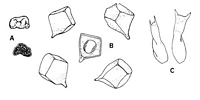
Caption: Fig. 30. Richoniellaceae, Richoniella pumila: A Habit and section (Dingley PDD 6171) x 1; B spores x 1750; C basidia x 1000. | 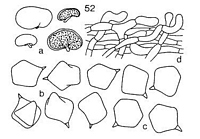
Caption: Richoniella
pumila Cunningham (herb. Hk. 68/235): a. carpophores.
b. spores. c. spores (holotype, PDD 8385). d. cuticle. | 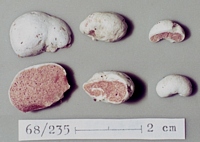
Caption: 68/235: Richoniella pumila
Owner: Egon Horak | 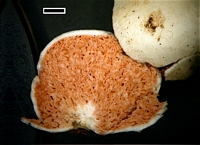
Caption: FUNNZ: 2006/1475, See public note for more information
Owner: FUNNZ | 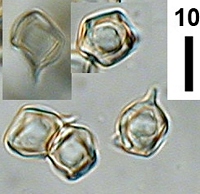
Caption: FUNNZ: 2006/1475, See public note for more information
Owner: FUNNZ | 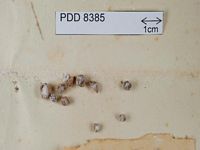
Caption: Dried type specimen
Owner: Herb PDD |
Article: Horak, E. (1973). Fungi Agaricini Novazelandiae I-V. Beihefte zur Nova Hedwigia 43: 200 p.
Description: Carpophores
3-24 mm diam., globose or irregularly tuberiform, folded near the base, pure
white, turning pallid cream or ochraceous, smooth, dry, peridium covering the
gleba but in old specimen leaving the gleba occasionally exposed. Gleba irregularly
labyrinthiform, loculi not radially arranged, cells up to 2 mm diam., columella
absent or only rudimentary, vivid pink, later becoming pallid ferruginous, not
gelatinous. Stipe absent or present, short cylindrical, concolorous with peridium,
without rhizoids. Odor and taste not distinctive. Chemical reactions on peridium:
KOH, HCl or NH3 - negative.
Spores
9-12 x 7-10 µm, rhomboid or 5-angled, pink, smooth. Basidia 26-35 x 10-11 µm,
4-spored. Cystidia none. Cuticle a cutis of short cylindrical, densely interwoven,
hyaline hyphae (5-10 µm diam.), membrane thin-walled, not gelatinized. Clamp
connections absent.
Habitat: On
ground among litter of Dicksonia sp., Carpodetus serratus, Ouintinia
sp., etc. New Zealand.
Notes: From
the taxonomical point of view Richoniella pumila represents a very interesting
species with highly reduced macroscopical characters. The tuberiform gastrocarp
(pileus) rarely exposes the loculate gleba (lamellae) and a fragile stipe may
be observed only occasionally. The microscopical characters of Richoniella
do not differ widely from those of Entoloma (Fr.) or Rhodogaster
Hk., another secotioid genus, linking Richoniella with Entoloma (Fr.).
Article: Beaton, G.W.; Pegler, D.N.; Young, T.W.K. (1985). Gasteroid Basidiomycota of Victoria State, Australia: 5–7. Kew Bulletin 40(3): 573–598.
Description: Gasterocarp 0.5-2.5 cm diam., globose to irregularly ellipsoid, basally attached, at times laterally coalescent. Peridium pure white to pale salmon pink
or ochraceous, dry, smooth, glabrous, narrowly exposing the gleba at base in old specimens. Gleba greyish orange (M.6.5YR/5.1/5.1), labyrinthoid to
loculate, consisting of empty, irregular or elongated, minute chambers, 0. 5-1.5 mm diam., elongated in basal region, without any radial arrangement.
Tramal plates 50-120 µm thick, not gelatinized, consisting of a broadly hymenophoral trama and extremely narrow subhymenial layers; peridial
context of slightly inflated, thin-walled hyphae, 3-15 µm diam.; clamp-connexions absent. Columella absent or rudimentary, not gelatinized; sterile
base generally absent, rarely present. Spores 8-12 x 6.5-10.5(10 ±0.8 x 9 ±0 5) µm, Q= 1.10; asymmetric, cuboid, with four or five angles visible in
lateral view, pinkish brown, with a slightly thickened smooth wall, and containing a single, large oil guttule. Basidia 22-33 x 5-l0 µm, cylindric
clavate, bearing two short sterigmata, soon collapsing especially towards the apex. Hymenophoral trama regular, broad, hyaline, not gelatinized, of
parallel, hyaline hyphae, 2-8 µm diam. Subhymenial layer very narrow, interwoven. Peridiopellis a repent epicutis, 20-40µm thick, of parallel, hyaline
hyphae, 3-6µm diam., with a slightly thickened wall. Figs. 30 A-C, 31 G-Q.
Notes: Hitherto known only from New Zealand, this species is easily recognized by the small size and cuboid spores. Many of the spores are truly cuboid i.e.
Type IX (Pegler & Young 1979b: 298), isodiametric, with six quadrangular facets forming a dihedral base, and a single adaxial and abaxial facet,
together with a dihedral pair of lateral facets. However, the majority of the spores are of the Dihedral Base type (Type X) in which the cube is
truncated by an extra apico-adaxial facet. The species has only been found once in Victoria, occurring scattered, in small clusters.
|